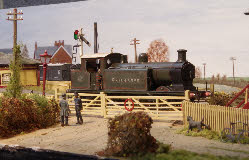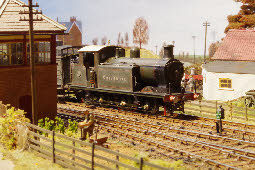



Added August 2016
E3 no 165 ex ‘Blatchington’
E4 no 566 ex ‘Durrington’
E4 no 468 ‘Midhurst’
E4X no 478 ex ‘Newick’
E5 no 584 ‘Lordington’
E6 no 410 ‘Chilgrove’
Following William Stroudley’s experiments with modifications to his 0-6-0 tanks in the form of his E1R ‘West Brighton’, his successor Robert Billinton developed a series of 0-6-2 tanks, starting with the goods E3’s. He followed this with the E4 mixed traffic (5ft wheels), E5 passenger tanks (5ft 6” wheels), and finally E6 heavy goods (4ft 6” wheels). Many of the E4, E5 and E6 classes were reboilered with I1 or I2 boilers. Those with the larger I2 boiler had the suffix ‘X’ added as in ‘E4X’.
 The final development of the Brighton 0-
The final development of the Brighton 0-6-2T radial tanks was the E6, a heavy goods variant of the E5, differing principally in the wheel size, at 4’6” diameter, as in the E3’s. The E3’s had proved themselves as useful engines, but were found wanting as the weight and speed requirements of goods trains increased.
 In total 12 E6’s were built in 1904 and 1905. The engines were mostly engaged in duties around London, and two of the class were used as yard-
In total 12 E6’s were built in 1904 and 1905. The engines were mostly engaged in duties around London, and two of the class were used as yard-marshalling shunters at New Cross  and Battersea. No 410 was shedded at Tunbridge Wells, where it remained until 1920, although whether it would ever have appeared on the Keymer-
and Battersea. No 410 was shedded at Tunbridge Wells, where it remained until 1920, although whether it would ever have appeared on the Keymer-Lewes line through Plumpton is doubtful.

 Our model, built by Chris, is an Albion models kit -
Our model, built by Chris, is an Albion models kit - the first kit-built Brighton loco to appear on our layouts, all the rest being scratchbuilt. The chassis is fully compensated, with a perspex radial trailing axlebox, driven on the central axle using a Portescap motor and gearbox. Electrical pickup uses split axles in common with virtually all locos on the layout.
The final photo (below, right) shows the comparison between the E3 (built in 1894) and the later, larger E6 (built in 1905).


E3 no 165 ex ‘Blatchington’
E4 no 566 ex ‘Durrington’
E4 no 468 ‘Midhurst’
E4X no 478 ex ‘Newick’
E5 no 584 ‘Lordington’
E6 no 410 ‘Chilgrove’
Following William Stroudley’s experiments with modifications to his 0-
 The final development of the Brighton 0-
The final development of the Brighton 0- In total 12 E6’s were built in 1904 and 1905. The engines were mostly engaged in duties around London, and two of the class were used as yard-
In total 12 E6’s were built in 1904 and 1905. The engines were mostly engaged in duties around London, and two of the class were used as yard- and Battersea. No 410 was shedded at Tunbridge Wells, where it remained until 1920, although whether it would ever have appeared on the Keymer-
and Battersea. No 410 was shedded at Tunbridge Wells, where it remained until 1920, although whether it would ever have appeared on the Keymer-
 Our model, built by Chris, is an Albion models kit -
Our model, built by Chris, is an Albion models kit -The final photo (below, right) shows the comparison between the E3 (built in 1894) and the later, larger E6 (built in 1905).

